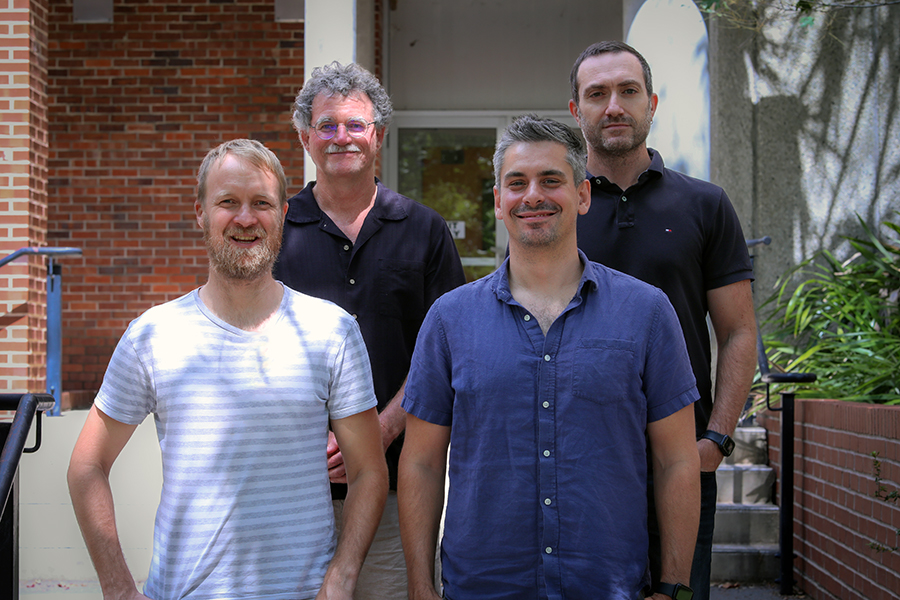FSU researchers earn NSF grant to apply novel mathematical tools to experimental data on sense of taste

Four Florida State University faculty members are recipients of a new grant from the National Science Foundation that will fund collaborative research aimed at improving our knowledge of an understudied area of biology: the sense of taste.
Distinguished Research Professor of Mathematics Richard Bertram, who also holds appointments in FSU’s Institute for Molecular Biophysics and Program in Neuroscience, will lead the project, funded by a $430,000 grant, to uncover new patterns in the neural codes that communicate our sense of taste using unique mathematical methods.
In “New Approaches for Interpreting Neural Responses to Behaviorally-Relevant Sensory Stimuli,” Bertram, along with Associate Professor Martin Bauer and Assistant Professor Tom Needham in the Department of Mathematics and Assistant Professor Roberto Vincis in the Department of Biological Science and Program in Neuroscience at FSU, will leverage recently developed tools from mathematics and network science to uncover patterns of electrical activity of neurons in the brain that code information about the foods we eat.
“The brain is made up of billions of tiny cells called neurons,” Vincis said. “These neurons communicate through electrical signals to share and process information about the world around us, enabling us to navigate our environment, to shape our behaviors, and to create lasting memories. What we’re trying to understand is the patterns of these electrical signals (i.e., the neural code) that explain sweet and sour, cold and hot, good and bad flavors in the brain, and finally drive our eating choices.”
“We’re applying new math tools that can extract these patterns not typically showcased by traditional methods,” Needham continued.
Using newly developed mathematical techniques, researchers hope to better understand how the brain senses taste, and these techniques can be used in many other areas of neuroscience where large data sets on human brain functions often manifest.
The cross-disciplinary project was born out of experimental data collected by FSU neuroscience doctoral student Cecilia Bouaichi and analyzed by FSU statistics alumnus Camden Neese (M.S., 2022), under the direction of the interdisciplinary team of professors, which resulted in a study published in 2022 in the Journal of Neuroscience. FSU biomathematics doctoral student Audrey Nash has since joined the team and is analyzing new data sets in different ways.
“This project has blossomed into a larger opportunity for biologists like myself to collaborate with mathematicians such as Bertram, Needham and Bauer to leverage new data analysis that will significantly enhance our ability to decipher and extract meaningful insights from large neuroscience data sets,” Vincis said.
As one of NSF’s recently established funding programs, Emerging Mathematics in Biology is intended to facilitate developments of biology-inspired mathematical theories, methodologies and innovative modeling approaches to advance understanding of challenging biological problems. Funding from this program will allow these four FSU scientists to bring on more research assistants to work on the project.
“We’re truly grateful for this NSF funding because it allows the incredible students who work with us daily to continue pursuing their interests in the project,” Bauer said. “Not only does this grant open opportunities for our students to pursue advanced research and travel to conferences, but it makes them more competitive for the impending job market in academia or industry upon their graduation.”
Because this project prompts potential discoveries in both math and biology, scientists have utilized cross-departmental and cross-disciplinary relationships, allowing them to learn from each other weekly and brainstorm new directions for the project according to their respective fields.
For Needham and Bauer, this means using pure math concepts for more concrete applications. For Vincis and Bertram, this means further pursuing the inner workings of the human nervous system from an interdisciplinary perspective. Together, the team plans to build a comprehensive mathematical toolkit for future scientists to apply to brain research on the sense of taste and other concepts.
“I have worked with experimentalists my whole career in both biology and math, and it’s the best part of my job,” Bertram said. “I’m always applying my math towards biological things, so it’s been hugely beneficial having people with many different skillsets on the team. My hope is that through NSF’s support and many others willing to do the work, we can continue to cultivate an environment of interdisciplinarity at FSU for professors and students now and in the future.”
To learn more about mathematics research at FSU, visit math.fsu.edu. To learn more about FSU’s biological science and neuroscience research, visit bio.fsu.edu and neuro.fsu.edu.

